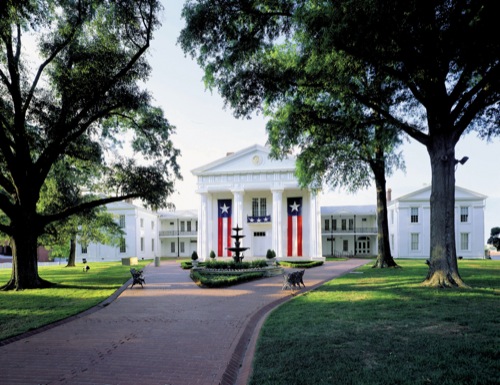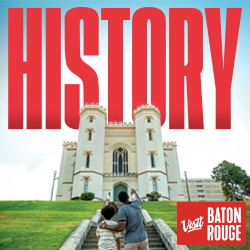
Courtesy Little Rock CVB
From California to New York, the rich fabric of our history tells us about those who have gone before us and helps us to understand who we are today.
Civil rights sites, Old West towns, historic railroads and other attractions help groups learn about a wide variety of historic periods and events. Many Travel Alliance Partner tours take visitors to historic places that give a unique perspective on local, state and national history.
If there are history buffs in your group, round them up for a tour that visits one of these fascinating places.
Las Cruces, New Mexico
With 350 days of sunshine annually, Las Cruces has a rich history that can be explored year-round. Manso Indians inhabited this area when the Spanish began colonizing the region in 1598. Eventually, the Mexican empire claimed ownership of the territory, and a town called Mesilla became the area’s leading settlement.
“From Mexican-American to farming and ranching, our area’s history is as diverse as our people,” said Chris Faivre, director of marketing and communications at the Las Cruces Convention and Visitors Bureau.
Historic Mesilla hasn’t changed much over the years. The settlement became part of the United States in 1854 with the Gadsden Purchase. Groups can wander this 1800s border town where Billy the Kid once stood trial for murder. The Mesilla Plaza, now filled with shops, art galleries and dining, was a major stop for the Butterfield Stagecoach. At the center of the plaza, visitors will find the Basilica of San Albino. Originally built of adobe in 1855, the church still celebrates masses in English and Spanish.
The New Mexico Farm and Ranch Heritage Museum, a 47-acre interactive museum, chronicles 3,000 years of New Mexico’s farming, ranching and rural life. Exhibits include information on diverse topics such as historic saddlemaking and the New Mexico dairy industry. Cattle-milking, blacksmithing and roping demonstrations take place regularly. The outdoor Antique Equipment Park displays farm implements from planters to plows.
Groups can learn about New Mexico’s livestock history and today’s producers on a guided trolley pulled behind a tractor at the museum. The tour travels across a 1902 steel truss bridge to the corrals and barns. Talks detail the different breeds of cattle, horses, sheep and goats raised at the center that have played a part in New Mexico’s agricultural history.
www.lascrucescvb.org
Little Rock, Arkansas
Much of Little Rock’s history centers on the Civil Rights movement and the city’s architecture.
“We have an embarrassment of riches when it comes to history,” said John Mayner, vice president of marketing and communications at the Little Rock Convention and Visitors Bureau. “We also work with two tour operators in town that provide step-on guides for a variety of tours and customized itineraries.”
Downtown’s collection of museums includes the state Capitol and the Old State House Museum, a fine example of Greek Revival architecture. The Historic Arkansas Museum recounts state history from the days of the Arkansas territory through the present. For groups, interpreters and storytellers bring the past to life.
The current state Capitol stands as a three-quarter replica of the nation’s Capitol building. Below the governor’s office, “Testaments,” the civil rights memorial sculpture of the Little Rock Nine, stands as a reminder of past turmoil. African-American students courageously integrated Little Rock Central High School in 1957. It’s the only memorial of its kind located on state Capitol grounds in the South.
“The life-size statues stare at the governor’s window so that each Arkansas governor will be reminded of what is morally right, not what is politically expedient,” said Mayner.
Also downtown, Central High School’s national park visitors center tells the story of the Little Rock Nine. Groups can also explore Arkansas’s African-American heritage at the Mosaic Templars Cultural Center. The center focuses on black-owned businesses and black legislators in the 1890s. Firsthand accounts of segregated life give a closer look at the plight of blacks in the Deep South.
Richmond, Virginia
The Civil War takes center stage in Richmond, the physical and psychological prize over which two mighty American armies contended in bloody battle from 1861 to 1865. Two major Civil War museums interpret those historic events.
Housed in an 1861 gun foundry, the American Civil War Center is the first museum of its kind. It explores the war through the interwoven perspectives of three groups: Union soldiers, Confederate soldiers and African-Americans.
The Richmond National Battlefield Park Visitors Center houses exhibits and audiovisual programs that introduce the story of Richmond during the war. It also highlights the battlefields and related sites surrounding the city. Step-on tours can highlight any of eight different battlefields at the park. In summer, groups can eat a catered meal or a boxed lunch under a large tent.
At a bridge across the street, groups can learn about Richmond’s Civil War past. The Richmond and Petersburg Railroad Bridge over the James River was blown up by the Confederate army after Richmond’s citizens fled from the approaching Union army.
“It’s one of the most treasured, hidden gems of the city,” said Janie Lawson, tourism sales manager, Richmond Metropolitan Convention and Visitors Bureau. “The spot affords a view of the present-day city as well as the historic pylons of the past.”
Another of Richmond’s most treasured historic sites is St. John’s Church, site of the second Virginia Convention, where Patrick Henry famously proclaimed, “Give me liberty or give me death.” On Sundays in the summer, historical interpreters re-enact that scene for visitors.
“It gives me chill bumps, and I see it least three times a year,” said Lawson. “They encourage the audience to pound on the pews, and they become part of the delegation.”










